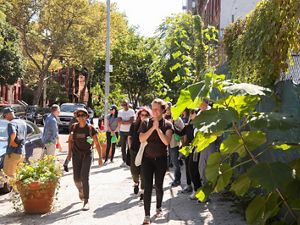Nurturing the Big Apple’s Forest
New York Cities Program Director Emily Nobel Maxwell advances natural solutions to some of Gotham’s most serious problems.
Emily Nobel Maxwell describes the work she does as The Nature Conservancy’s New York Division Cities Director as the “marriage of science and policy.” What that means is that she spends her time looking for answers to questions like, “What benefits do trees offer cities?” And, “How can government, civil society groups, and property owners work together to expand nature in urban settings, especially in ways that increase equity, build community, adapt to extreme weather, and reduce temperatures in the hottest—and often the poorest—of neighborhoods?”
The State of the Urban Forest in New York City
Our report details the vulnerabilities and opportunities ahead for our urban forest.
DownloadFor Maxwell, these questions tie deeply to who she is: someone with a visceral connection to people and to other living things. Her passions have led her to champion New York’s urban forest in particular—its more than 7 million oaks, sycamores, hickories, magnolias and more. At present, there is no entity, public or private, that manages, maintains and develops this crucial resource. “Can you imagine having an asset valued at $5.7 billion, without a clear, funded plan or sufficient leadership to care for it as a whole, now and into the future?” she asks. Her work, including co-authorship of a first-of-its-kind report titled The State of the Urban Forest in New York City, is a years-long effort to change that.

Maxwell’s love of both cities and nature started early. “When I was fairly little, my mom woke me up at two in the morning because there was a tiny owl sitting on the tree outside our house in Philadelphia,” she recalls. The “very alternative” elementary school she attended took kids out to an old farm at the city’s edge once a week and let them roam free.
These experiences and others led Maxwell, then in college at New York City’s The New School, to organize against the Giuliani administration’s proposed, 1999 sell-off of more than 100 City-owned lots that were home to community gardens. “I thought this was such a horrifying way to treat the gardeners and the lands,” she says. “These gardens wouldn’t have existed without the love of community members, who made the land valuable enough to sell in the first place.” Many of the gardens, and the communities that grew up around them, exist to this day.
Quote: Emily Nobel Maxwell

Trees are about trees. But they’re also about people—how people feel when you invest in their blocks and when they get to invest in their blocks, too.
When Maxwell joined The Nature Conservancy eight years ago, she set out to help the organization actualize the essential role cities can play in conservation. Toward that end, she and her team champion trees for their many benefits. As someone with a strong connection to a particular Osage orange in Brooklyn’s Prospect Park, Maxwell knows well how trees can uplift the spirit, with study after study showing that trees can help reduce depression, anxiety and crime. Trees retain stormwater and filter air pollution. Their shade cools people, streets and buildings. And, of course, trees sequester carbon. All these benefits are especially important in a climate-changing world where storms are more frequent and intense, and summer temperatures can spike dangerously high.


Today, Maxwell co-leads the 40+-member Forest for All NYC coalition to promote wise protection, careful stewardship and just expansion of the Big Apple’s tree canopy. Earlier this year, the group released its roadmap: the NYC Urban Forest Agenda. In it, the group calls for a significant increase in the city’s forest canopy, a master plan to invest in and manage New York’s urban forest, and more equitable access to trees and their advantages. As things stand now, the city’s lushest neighborhoods are often its wealthiest and whitest. Data show that residents of neighborhoods with the least vegetation are often the most vulnerable to extreme weather—especially heat waves and flooding.
Quote: Emily Nobel Maxwell
We want to make sure the whole forest thrives and expands to help the city—especially its frontline communities—adapt to climate change now and in the years to come.
Key to implementing this roadmap is a new report released this November. It details the city’s tree canopy on a neighborhood-by-neighborhood level and offers particulars on the physical and social infrastructure that supports it. “New York City’s forest is an asset we cannot afford to let go—and one whose benefits must reach more people,” Maxwell says. “We want to make sure the whole forest thrives and expands to help the city—especially its frontline communities—adapt to climate change now and in the years to come.”
Learn More about Future Forest NYC
With partners, we're helping to map out a clear, coordinated vision for New York City’s trees.



